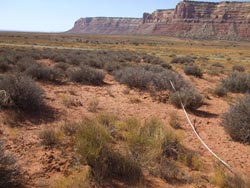Plant production could decline as climate change affects soil nutrients

The cliff face of Cedar Mesa, in southeast Utah, overlooks one of many sites sampled in the world's drylands. <br>
That includes people living in Arizona, who may be in for a dustier future.
The findings are presented in a study published in Nature that details how soil changes may occur and discusses the implications. Co-author Matthew Bowker, assistant professor of forest soils and ecosystem ecology at Northern Arizona University, was involved with the project since 2009.
Bowker explained that most of the 17 nutrients that plants need to grow to their potential are soil resources, such as nitrogen and phosphorus. The statistical model he helped develop for the study suggests that as the climate becomes more arid, nitrogen will decrease and phosphorus will increase.
“Both are essential for plant growth, and both are typical components of fertilizer, but both need to be around in the right quantities for plant growth to proceed most efficiently,” Bowker said.
“It’s like a situation where you’re making hamburgers but run out of beef. You can’t just slip in another bun and still produce a hamburger.”
Drylands, which are defined by predominantly lower levels of moisture, cover about 41 percent of the earth’s surface. The study suggests that people who depend on those ecosystems for crops, livestock forage, fuel and fiber will find their resources increasingly restrained.
In Arizona, Bowker said, the projected decrease in plant production could magnify the impact of dust storms, which have been increasing in recent decades.
“We can probably expect more and more dust in the air,” he said.
The project involved visits by research teams in 16 countries to 224 locations on every continent except Antarctica. Bowker led one of the sampling teams, which visited 10 study sites in northern Arizona and Utah. Those sites ranged from dry, grassy shrublands with low precipitation to relatively wet sagebrush ecosystems.
“This is a testament to the power of networked science,” Bowker said, adding that it would have been “prohibitively expensive” for any one researcher or research group to complete the project.
Media Contact
More Information:
http://www.nau.eduAll latest news from the category: Ecology, The Environment and Conservation
This complex theme deals primarily with interactions between organisms and the environmental factors that impact them, but to a greater extent between individual inanimate environmental factors.
innovations-report offers informative reports and articles on topics such as climate protection, landscape conservation, ecological systems, wildlife and nature parks and ecosystem efficiency and balance.
Newest articles

Silicon Carbide Innovation Alliance to drive industrial-scale semiconductor work
Known for its ability to withstand extreme environments and high voltages, silicon carbide (SiC) is a semiconducting material made up of silicon and carbon atoms arranged into crystals that is…

New SPECT/CT technique shows impressive biomarker identification
…offers increased access for prostate cancer patients. A novel SPECT/CT acquisition method can accurately detect radiopharmaceutical biodistribution in a convenient manner for prostate cancer patients, opening the door for more…

How 3D printers can give robots a soft touch
Soft skin coverings and touch sensors have emerged as a promising feature for robots that are both safer and more intuitive for human interaction, but they are expensive and difficult…





















